ASUS F1A75-V Pro vs. Gigabyte GA-A75-UD4H – Llano at ~$120
by Ian Cutress on November 7, 2011 6:00 AM EST- Posted in
- Motherboards
- Gigabyte
- Asus
- A75
Test Setup
| Processor |
AMD Llano A6-3650 4 Cores, 4 Threads, 2.6 GHz |
| Motherboards |
ASUS F1A75-V Pro Gigabyte GA-A75-UD4H |
| Cooling | Corsair H50-1 |
| Power Supply | Silverstone 1000W 80 PLUS Silver |
| Memory |
G.Skill RipjawsX DDR3-1866 9-10-9 28 2x4GB Kit 1.5V Patriot Viper Xtreme DDR3-2133 9-11-9 27 2x4 GB Kit 1.65V |
| Memory Settings | DDR3-1866 |
| Video Cards |
XFX HD 5850 1GB ECS GTX 580 1536MB |
| Video Drivers |
Catalyst 11.8 NVIDIA Drivers 280.26 |
| Hard Drive | Micron RealSSD C300 256GB |
| Optical Drive | LG GH22NS50 |
| Case | Open Test Bed - CoolerMaster Lab V1.0 |
| Operating System | Windows 7 64-bit |
| SATA Testing | Micron RealSSD C300 256GB |
| USB 2/3 Testing | Patriot 64GB SuperSonic USB 3.0 |
Comparison to Other Reviews
Where applicable, the results in this review are directly compared to the following chipsets and boards which we have reviewed previously.
Power Consumption
Power consumption was tested on the system as a whole with a wall meter connected to the power supply, while in various configurations. This method allows us to compare the power management of the UEFI and the board to supply components with power under load, and includes typical PSU losses due to efficiency. These are the real world values that consumers may expect from a typical system (minus the monitor) using this motherboard.
IGP:
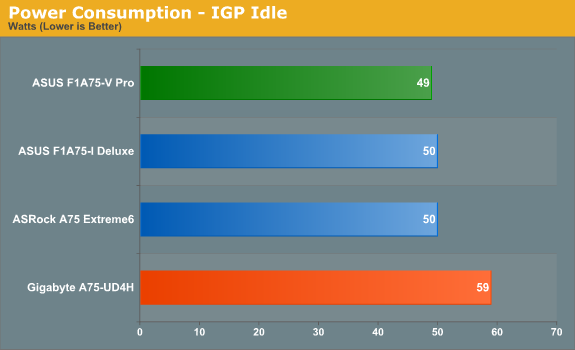
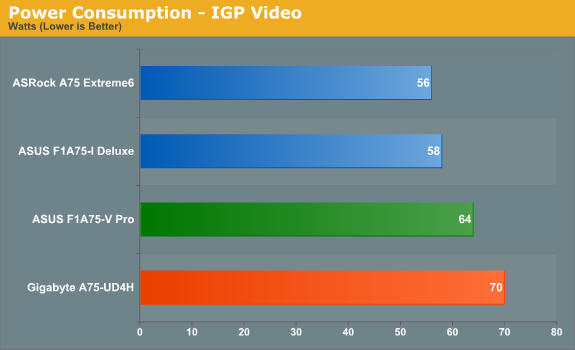

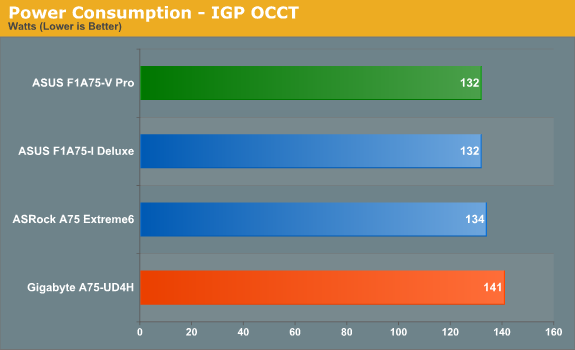
In terms of power usage while in IGP mode (power supply efficiency aside), we see that the ASUS commonly draws less power than the Gigabyte board in all scenarios..
Two 5850s:


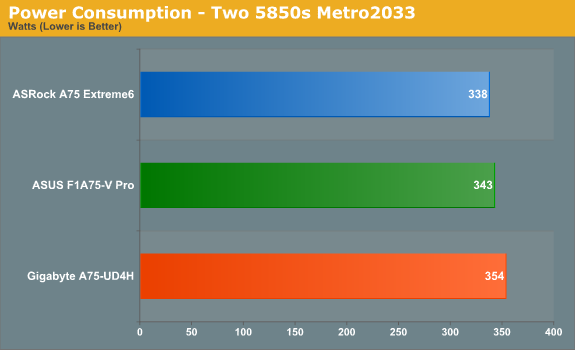
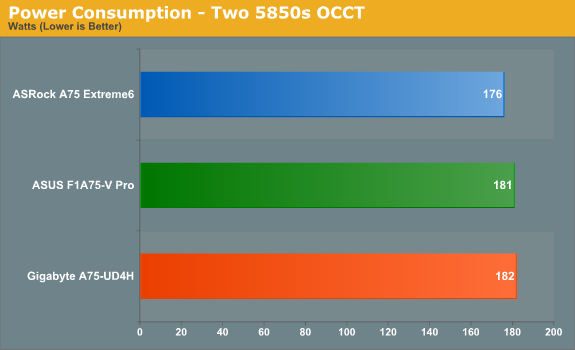
When two 5850s are used in the system, we see peak power numbers around 350W when gaming. Neither board stands out here against the other.
CPU Temperatures
With most users’ running boards on purely default BIOS settings, we are running at default settings for the CPU temperature tests. This is, in our outward view, an indication of how well (or how adventurous) the vendor has their BIOS configured on automatic settings. With a certain number of vendors not making CPU voltage, turbo voltage or LLC options configurable to the end user, which would directly affect power consumption and CPU temperatures at various usage levels, we find the test appropriate for the majority of cases. This does conflict somewhat with some vendors' methodology of providing a list of 'suggested' settings for reviewers to use. But unless those settings are being implemented automatically for the end user, all these settings do for us it attempt to skew the results, and thus provide an unbalanced 'out of the box' result list to the readers who will rely on those default settings to make a judgment.
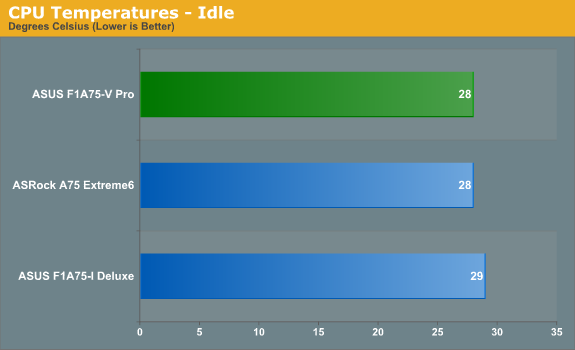
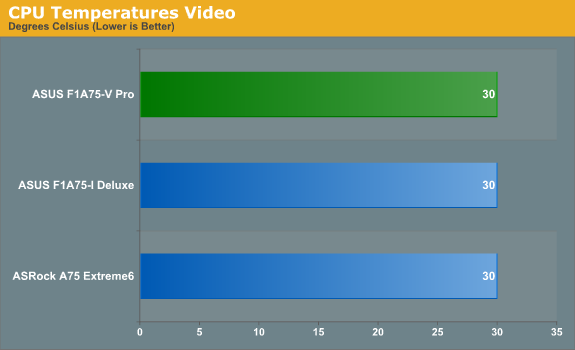

Unfortunately, the Gigabyte board did not provide proper numbers for us to work with. The system stated the CPU was idling at 14 C, while the room was ambient at around 19 C. I am awaiting a response from Gigabyte on the issue.










47 Comments
View All Comments
DanNeely - Monday, November 7, 2011 - link
"It should be noted that, according to the Gigabyte website, the DVI-D does not support D-Sub by adaptor, and that when on integrated graphics, the connector cannot be changed while the motherboard is powered up."This sort of no plug and play nonsense is a throwback to the 90s, and has no business on a modern board.
Oberst - Monday, November 7, 2011 - link
This is quite misleading, as both mobos use a DVI-D. So also both do not support D-Sub via adapter, Gigabyte is just the only manufacturer that clearly stresses this issue, all others assume that you know what the difference between DVI-D and DVI-I is.Also no word is left, that the gigabyte board is capable of Dual Link DVI, while the asus only allows single link, which enables only a limited range of display resolutions. As Dual Link on Llano boards is not very common, that would surely be some important fact to mention.
I'm also not quite sure, what gigabyte means with "All integrated graphics ports do not support Hot plug. If you want to change to another graphics port when the computer is on, be sure to turn off the computer first." Maybe just a false translation, meaning you have to reboot the system, when changing the output (as the display driver doesn't switch the output automatically, you have to do that manually in the driver or by rebooting).
DanNeely - Monday, November 7, 2011 - link
It's the no-hotplug part that apalled me, I should've trimmed the 1st part of the sentence away to be clearer but was in a rush for the shower by the time I finished reading the articel.Oberst - Tuesday, November 8, 2011 - link
I'm not sure if that is really that strict as this statement shows. The Gigabyte translations are often not very good and the real meaning is quite different to the written text.When you change your display from DVI to DP, you have to do a reboot as the driver won't switch automatically. That's because you could just pull out a plug by hitting the cable accidentally. So the driver holds the primary output on the plug that was used before, only a reboot initiates a rescan of the displays and switches to another one.
So maybe gigabyte wanted to express this. That would definitely be something to try out. But i can't imagine that you cannot plug in a second monitor on a running system, that would really be some strange behavior.
Googer - Sunday, November 13, 2011 - link
Use a displayport adapter If you need DUAL LINK DVI connection on the ASUS board.Etern205 - Wednesday, November 9, 2011 - link
Yea, DVI-D doesn't support DVI to VGA adapter as there is no 4 analog pins on that DVI port. Also even if it doesn't have that 4 pin, the adapter still won't fit as the analog ground (that horizontal pin) on the adapter is a tad wider.Etern205 - Wednesday, November 9, 2011 - link
My mistake, looks like there is a DVI-D to VGA adapter and it's not the DVI to VGA adapter I was mentioning.DVI-D to VGA adapter
http://www.newegg.com/Product/Product.aspx?Item=N8...
DVI to VGA adapter
http://www.newegg.com/Product/Product.aspx?Item=N8...
cjs150 - Monday, November 7, 2011 - link
Really like layout of Gigabyte board. Although this is more of a problem with M-ATX boards I have struggled recently with fitting both graphics card with waterblock and a air cooler over the memory (fits but is incredibly tight) so seeing the PCIEx1 slot above the PCIex16 is a good move.What are all those legacy PCI slots doing there? What do people use them for? Across 5 computers at home I use 2 - I for a really old RAID card and one for a TV tuner. Is there really any need for them now?
Recently I have seen a board with right angled 24 pin ATX socket. Please can this become standard
Golgatha - Monday, November 7, 2011 - link
PCI is for your old sound card. Now if you're building new, there is no need for PCI to exist.Taft12 - Monday, November 7, 2011 - link
IDE controller, RS-232 card... Me and many like me still need a PCI slot, and Asus and Gigabyte's market research shows the same.PCI will still be with us for many years to come yet.